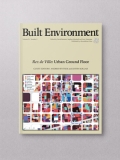
High-Speed Rail: Shrinking Spaces, Shaping Places
This special issue offers a unique expert view of the current HSR debate across the UK, Europe and the wider world. It offers a new and expert perspective on two central questions: the need to reconcile the huge scale of investment with public and political acceptability, and the challenge of maximising social value from that investment. Anyone involved in the debate will find it essential reading.
About this issue
Summary
This special issue offers a unique expert view of the current HSR debate across the UK, Europe and the wider world.
HIGH-SPEED RAIL (HSR) has become the truly significant twenty-first century land transport mode, as networks extend and connect across the world – principally in Europe and Asia, and above all in China. There is even the prospect of HSR (perhaps, belatedly) in California. But this has been accompanied by passionate controversy. In 2010, on 1 October, an estimated 100,000 people took part in a demonstration against the Stuttgart 21 project to build a new high-speed link under Stuttgart’s historic train station. Repeated legal challenges have held up the start of construction on California’s planned $68 billion high-speed line connecting San Francisco and Los Angeles. And in the United Kingdom, there is vocal opposition to the proposed High Speed 2 line from London to Manchester and Leeds, the estimated cost of which has already risen from £33 billion (2010) to £42 billion (2013), before construction has even started.
Underlying these debates are difficult issues of planning appraisal and decision-taking. Many critics question the application of traditional cost-benefit analysis, originally devised 50 years ago to measure the benefits from new highway construction and heavily weighted in favour of time savings, to railway construction: time spent on trains, they argue, is often not time wasted but time profitably spent on work-in-transit. And arguments that high-speed lines shrink time distances, bringing peripheral economically-deprived regions to central thriving places, are controversial because ways to measure the advantages are in their infancy. The experts themselves are divided, often reaching contrary conclusions.
So the editors of Built Environment have drawn on their own research, and of their colleagues, to produce this unique collection of expert papers. David Banister and Moshe Givoni open with a deeply-researched and wide-ranging overview of current financing and trends in European rail travel, especially HSR. They show that HSR can transform the geography of a country, bringing regions and cities closer to each other by improving accessibility, and creating (regional) economic development. Two factors prove central: the number and location of stations, and their integration into the rest of the transport network. A dedicated HSR network may provide the capacity for growth in long-distance travel – but, to be successful, it needs to be planned as the strategic backbone of the wider transport system.
Peter Hall follows with a comprehensive review of the complex history of High Speed Two (HS2), the most ambitious single transport project ever att empted in the UK – and, increasingly, one of the most controversial. Critics assert that the projections of future demand are exaggerated, that additional capacity could be secured more cheaply and effectively by improvements to the existing line, and that projections of time-savings ignore the value of working time on the train. Increasingly, he shows, the economic appraisal of the scheme may turn on its indirect benefits to regional development and urban regeneration.
In turn Hall collaborates with Chia-Lin Chen to review the key policy question: how to link new high-speed rail connections to regional rail networks so as to ‘irrigate’ deprived regions around key core cities. They argue that one aspect has been ignored: how strategic regional planning could enhance the opportunities offered by HSR for urban and regional development. This has been successfully achieved in northern France; they present a parallel UK vision, S-Map 2030 North West, to extend the advantages of HS2 across the region. Their colleague Robin Hickman and other colleagues further outline this vision for the future seamless public transport journey in 2030, drawing on the SYNAPTIC project (Synergy of New Advanced Public Transport Solutions Improving Connectivity in North West Europe), funded by the EU INTERREG IVB programme. They argue the critical importance of enhancing the passenger’s journey experience, illustrated by an animated future journey from Preston (UK) to Delft (the Netherlands).
Finally, Chia-Lin Chen and Biao Wei review China’s remarkable HSR network, planned to reshape the country’s economic geography. They examine the new Hangzhou East Rail station to argue that a critical feature of the system – huge airportstyle HSR stations in the suburbs of big cities, as the basis for new town development – leads to long and indirect journeys between their central areas, bringing little advantage in journey times compared with the traditional rail system.
This special issue offers a unique expert view of the current HSR debate across the UK, Europe and the wider world. It offers a new and expert perspective on two central questions: the need to reconcile the huge scale of investment with public and political acceptability, and the challenge of maximising social value from that investment. Anyone involved in the debate will find it essential reading.


